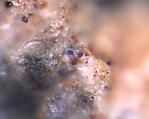On loan to The Met The Met accepts temporary loans of art both for short-term exhibitions and for long-term display in its galleries.
Marble female figure
Technical analysis: Ultraviolet-induced visible luminescence examination, optical microscopy, Raman spectroscopy
This fine-grained white marble figure is complete. A horizontal break at the base of the neck has been mended with adhesive and the join filled. Traces of the same colorless adhesive are visible above the nose, at both sides of the forehead, and at the right upper front corner of the head. The backward-tilted disproportionately long head is lyre-shaped with a rounded chin, flat crown, and wide triangular relief nose set in the middle on the face. The long cylindrical neck is offset from the torso by a shallow groove that is curved at the front and v-shaped at the back. The figure has slightly sloping angular shoulders with arms folded left over right, supporting low relief rounded breasts and sitting above a short narrow abdomen. There are no indications of fingers or a pubic triangle. Deep vertical grooves at the front and back indicate the legs, which are separated from the knees to the ankles. The outsplayed feet have no indication of toes. A shallow vertical groove on back indicates the spine. The back is flat with angular buttocks, the knees are slightly bent, and the flat feet are downward pointing.
There are scattered thick traces of yellowish-brown calcareous accretions, including numerous in the shape of rootlets. There is red pigment on the forehead, along the bottom of the chin, on the front right side and back of the neck, and below the left breast. The pigment extends over areas of erosion and accretions. Raman analysis of the red particles in the chin, the neck and below the breast identified them as fine-grained hematite. In addition to hematite, the area below the breast is characterized by the presence of abundant blue particles mixed to the red hematite. Raman analysis identified the blue particles as lazurite, which are interpreted as modern ultramarine. A horizontal band of smoother stone across the width of the upper front of the head and a larger area that narrows to a horizontal lower border on the back of the head, indicate the location of painted hair, or a polos, that has been lost. Each lower corner on the back of the hair, or polos, has the start of a curl. There are paint ghosts for the eyes. The right eye, with pupil, is in general better preserved than the left eye. Also visible above these is faint evidence in relief of painted eyebrows, or possibly another pair of eyes.
Georgios Gavalas, Sandy MacGillivray, Dorothy Abramitis, Linda Borsch, Federico Carò and Elizabeth Hendrix
This image cannot be enlarged, viewed at full screen, or downloaded.
This artwork is meant to be viewed from right to left. Scroll left to view more.








